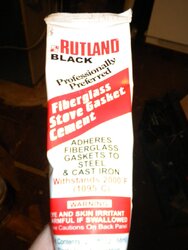Some folks say the stove connection to the first section of pipe, which has the hottest flue temps of the venting system, may be worth going with the 600 F rating. But I believe the 500 F is probably fine. Your stove's snap discs and high temp limit switches are designed specifically to shut down the pellet feed system if you get an over-fire in your stove, which should keep your vent from getting so hot that it started to compromise the silicone sealant integrity of your venting,
Yes, you can use it on the inside or outside of the vent, Taking them apart if you have to at a later date can be a challenge with both interior and exterior seals, (though it's less likely to leak smoke), so that's why allot of folks go with the silicone liquid sealant on the inside and silicone tape on the outside, which is easier to take apart if you need to, and for some, more aesthetically pleasing if you have allot of visible interior vent piping.
If you plan to to take your venting apart to DIY reseal it, since you have already had your vent silicone sealed, you may need to get a couple of strap wrenches to take them apart. Although your vent is new enough and hasn't been heat cured for an extended period yet, so it may come apart easier perhaps.
Removing all the old cured sealant and prep-ing the area with isopropyl alcohol or acetone is important to get the optimum bond, as new silicone won't stick to old silicone, despite what some sealant companies products claim.
If it were mine, I'd leave the vent together as is, remove all the exterior silicone the install guy gooped on, clean all vent junctions and metal to metal connections real well with iso or acetone solvents, then do the silicone tape wrapped around the junctions. As always, your results may vary......
Taking off the Rutland cement could be more problematic than the silicone, I will guess, as the directions say "after cement is dry, it can be removed by sanding, scraping or sand blasting", although again it hasn't been heat stressed extensively yet,so it may come off OK.
Good luck! There's always more to learn about this pellet stove stuff than you ever thought - huh? You guys are well into the 'steep learning curve' phase now !

Hopefully the light at the end of the tunnel is just that, and not still the on-coming train !

Cheers, and happy burning !


 *Hopefully* you are through the worst of your stove purchase 'odyssey' !
*Hopefully* you are through the worst of your stove purchase 'odyssey' ! 


 )
)